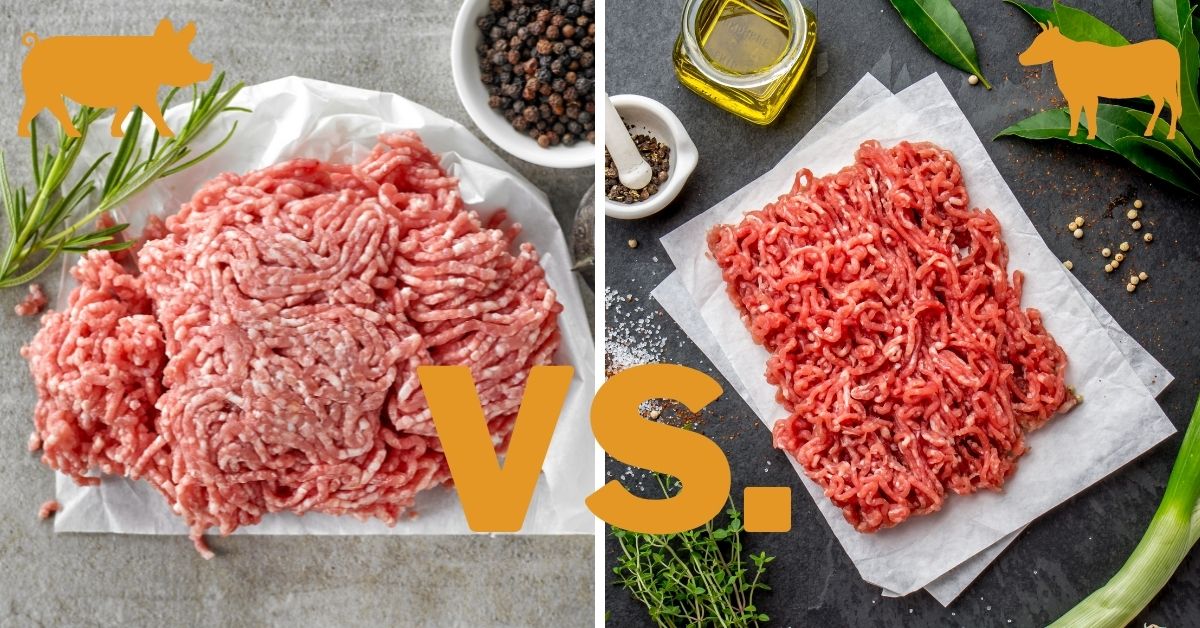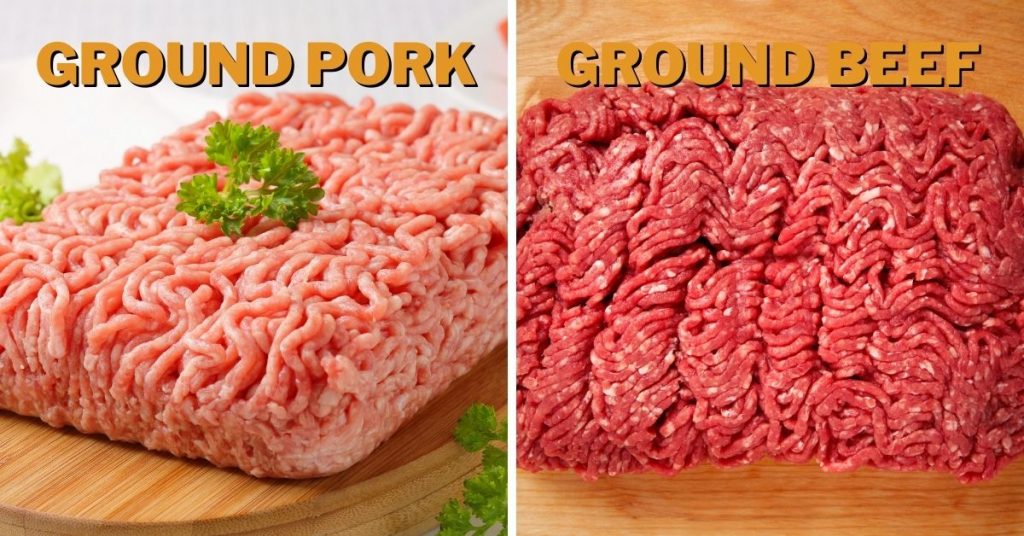Ground Pork vs. Ground Beef: Difference & Which Is Better?

Pork or beef – is a frequent choice that many people have to face whenever they are shopping in the meat aisle. Both are super popular and can be put into various dishes from different cuisines. But how do these two common sources of protein differ from one another?
Ground pork tends to have higher levels of protein, unsaturated fats, vitamins B1 and B2, whereas ground beef has more iron, zinc, and vitamin B12. [1] Additionally, ground beef is lower in calories but pork is lower in cholesterol and sodium. The price for both depends on the region and the cut of meat.
Of course, there are several other factors that differentiate ground beef from ground pork. And in this article, we are going to look at these factors in much more detail, compare them side by side, and see which type of meat is better in which circumstances.
Ground Pork vs. Ground Beef: Difference
So, ground beef is finely chopped beef and ground pork is finely chopped pork. But though the process is similar, these two types of meat are not the same. Several factors contribute to making them distinct from one another. So, let’s discuss them in more detail.
Appearance
Ground pork has a lighter color than ground beef. This lighter shade can actually confuse some people into thinking pork is white meat. For reference, red meat has more myoglobin, which gives it a reddish tone. In comparison, white meat is paler due to low levels of myoglobin.
But both beef and pork belong in the red meat category. It is just that the meat in cows tends to have more myoglobin. As such, ground beef is also redder and darker in color than ground pork.

Taste
It is pretty hard to identify one particular taste for either beef or meat. This is because different cuts of beef or pork will have different tastes and textures. Bacon is not going to taste the same as pork loin. Similarly, chuck steak is going to taste differently than sirloin.
But if you were to generalize their flavor profile, pork tends to have a milder taste compared to beef.
Texture
The amount of fat and water in your meat is going to play a big role in the texture of the final, cooked product. So, let’s say the meat you are cooking is very lean, meaning it has a low-fat content. This meat will take less time to cook through but will become very dry very fast. So, you have to be extra mindful of the marinating or braising process.
Since pork has a higher fat count in general, it tends to have more moisture when it is cooked. You have to be extra careful with very lean beef as it can become very chewy if you are not careful. But the overall texture will depend more on the cut of the meat.
Cooking Time
Cooking time depends on multiple factors. In the case of meat, two important influencers are connective tissues and fat content. In simple terms, the more connective tissue in the meat, the longer you have to cook to break it down properly.
Now, the fat content in beef is dependent on the cut. The 95% lean cut has less fat than 85% cut of beef. But for the most part, beef tends to take longer to cook through than pork.
- RELATED: How Much Ground Beef Is a Serving?
Nutritional Value
For people who are particularly concerned about the food they eat, knowing the nutritional content of meat is vital, be it beef or pork. This can help your judgment when selecting the right meat for your diet.
Calories
The calorie content relies heavily on the amount of fat in the meat. Since different cuts of beef or pork have varying levels of fat, their energy yield is also different.
According to the USDA, 100 grams of fatty beef, which is called chuck steak, has a calorie value of around 332 calories. This meat comes from the shoulder area. And 100 grams of ground sirloin beef has a calorie value of 129 calories. [2]
In comparison, 100 grams of fatty ground pork, which is 72% lean, generates 393 calories. And 100 grams of 96% lean ground pork will generate 185 calories. [3]
So, as you can see, the calorie yield of the meat varies greatly depending on which part of the animal it is from. But for the most part, beef has fewer calories than pork. This stems from the fact that pork, on average, has more fat and carbs by weight than beef.
Protein
Once again, you have to consider the leanness of the meat. The leaner the meat, the more protein it is going to have in place of the fat.
100 grams of 70% lean ground beef has a protein value of 14 grams. And the same amount of sirloin ground beef has a protein value of 21 grams. [4]
On the other hand, 100 grams of 72% lean ground pork has 23 grams of protein. And 100 grams of very lean (almost 96%) pork has around 32 grams of protein. [5]
So, gram per gram, ground pork has a higher protein value than ground beef. This is crucial when calculating the daily protein requirement and how much of that you want it to come from meat.
Fat
When looking at the fat content of food, you need to look at both the total fat level as well as the amount of saturated and unsaturated fats separately. Because the total fat amount on its own is not enough of a good indicator. Food can be fatty and still be good for your health if most of the fat is of the unsaturated variety.
In the case of fatty beef, there are 30 grams of total fat per 100 grams of meat, of which 11 grams are saturated. And in the case of ground sirloin, the total fat amounts to 4.5 grams per 100 grams of meat. The saturated fat level here is 1.5 grams. [6]
In contrast, ground pork made from 72% lean meat has 33 grams of fat per 100 grams, of which 11 grams is saturated fat. And ground pork made from a 96% cut has only 6 grams of total fat. Here, the saturated fat amounts to 2.1 grams. [7]
So, here are the takeaways from this discussion. On average, pork meat has a higher total fat content than beef.
But it is also important to note that pork contains more unsaturated fats per 100 grams than beef. Since unsaturated fat is more important, pork is a better source of this nutrient than beef. So, pork is richer in both total fat and unsaturated fatty acids.
Cholesterol
Since in general, pork has higher levels of saturated and total fat, it also has a higher cholesterol yield than beef. So, keep this in mind when you are planning to include pork or beef into your diet.
Vitamins
There are so many vitamins, most of which are essential and must be supplied through your diet. So, here is how ground beef and pork stack up against one another in this important category:
Pork is remarkably richer in terms of vitamin B1. In fact, 100 grams of pork can fulfill about 56% of your daily vitamin B1 requirement, whereas ground meat can only do about 6%. Pork is also significantly richer in vitamins B2 and B6 compared to ground beef. Where beef has the upper hand over pork is with vitamin B12 or cobalamin. This vitamin is essential for making blood cells in our body. 100 grams of beef can meet up to 40% of your daily cobalamin needs. 100 grams of pork can meet up to 20% of daily cobalamin. [8] [9]
Another point of difference is vitamin D, which is needed for the formation of bones and teeth. Beef has little to no amount of vitamin D, while pork can meet up to 13% of your daily requirement.
One important factor to note is that many vitamins are fat-soluble. So, if the piece of meat has a higher fat content, it will likely have higher levels of fat-soluble vitamins such as vitamin A and D.
Minerals
Ground beef is considerably richer in both zinc and iron, two crucial minerals for our body. In fact, beef has nearly double the amount of iron compared to pork and is generally a good source of it.
Pork, on the other hand, is slightly better when it comes to potassium, magnesium, and phosphorus; although the difference here is not as significant.
Popularity
According to the consumer data organizing website Statista, beef is a more popular choice in the United States than pork. However, if you take a look at the meat consumption level around the world, you will find that people consume pork more than they do beef. This is probably because pork is usually less expensive than beef.
Ground Pork vs. Ground Beef: Which Is Better?
Well, this depends on how you approach this topic. If you are looking from the perspective of health and welfare, you will realize that pork is richer in some nutrients while beef is better for others. So, depending on your diet, one type of meat may suit you more.
For example, if your diet is lacking in iron and/or vitamin B12, you can choose to eat ground beef. Beef is an excellent source of both of these nutrients. Alternatively, you can choose pork to fulfill the need for vitamin B1 with a higher protein content by weight.
Additionally, you can look at this from a taste and texture perspective. Pork has more fat, which can go particularly well with some dishes. This may sway your opinion on which meat is better. But of course, the taste is an entirely personal thing.
In terms of availability, you have to factor in the region you are in as well as the demand. Some religious practices ban the eating of pork, while some view cows as holy animals. Some regions have more dairy farms than they do pig farms. All this can affect the availability and price of the meat, which will determine the best meat for your status.
So, in summary [10]:
| Ground Beef | Ground Pork |
|---|---|
| Fewer Cholesterol and Calories | Richer in Protein and Unsaturated Fat |
| More Iron and Zinc | More Potassium and Magnesium |
| More Vitamin B12 | More Vitamin B1 and D |
| Less Fat; Becomes Dry Quickly | More Cooking Time; More Moisture |
Can You Mix Ground Pork and Ground Beef?
You can definitely mix ground beef and ground pork together to make a dish. There can be several benefits to doing this. You may be short on one kind of meat. Or you simply want to try something new to rejuvenate your palate. Whatever the case, mixing ground beef and pork is a viable option.
Now, a cause for concern is the temperature at which you should cook the meat. But fortunately, beef and pork have roughly the same cooking temperature. So, if you cook your mixed patty up to 160 degrees Fahrenheit, the meat will be safe for eating. Also, if the leanness of both ground meat is similar, it will help in cooking the mixed meat evenly.
What Can You Make With Ground Beef?
Ground beef is like soft clay; you can mold it into pretty much any shape and size you want. So, you can make several different dishes with it.
You can make meatballs and add them to a soup or sub-sandwich. You can create lasagna or enchiladas if you are feeling a bit exotic. Or you can try the classic and make it into a patty for a burger. You can also add it to nachos, tacos, or use cooked ground meat as stuffing for various dishes. Another famous meal with ground beef is chili con carne. Or you can make a protein-rich salad if you are feeling a bit health-minded.
What Can You Make With Ground Pork?
Whatever you can make with ground beef, you can make with ground pork as well. So, you have your nachos, enchiladas, tacos, meatballs and meatloaf, lasagna, salad, etc. Moreover, you can add ground pork to noodles, ramen, or even soup.

Is Ground Pork Healthy?
Ground beef is a healthier choice if you are looking for iron, cobalamin, and zinc in your diet. It also helps that lean ground beef has lower cholesterol than pork with fewer calories. So, ground beef is a better choice for keeping your weight in check.
But pork is the better choice when it comes to unsaturated fats, vitamins B1 and B2, as well as potassium and magnesium. [11]
Ground meat is incredibly common in both professional restaurants and personal kitchens, be it beef or pork. And the best part is that you can go for either meat and even mix them up in the same recipe.
What Is Considered Ground Meat?
Ground meat is any type of meat that has been finely chopped or “ground.” You can achieve this manually by cutting the meat into fine shreds with a kitchen knife. Or you can do this with the help of a meat grinder.
Is Ground Meat the Same as Keema?
This specific style of meat has different names. People in America call it ground meat or ground beef, as that is how this product is sold on the market. Minced meat is also a common term that describes the same sort of meat.
But in the Indian subcontinent, most people know ground or minced meat as “keema”. Traditionally, this keema is turned into a ball and fried. But there are several other ways people in the subcontinent can enjoy keema. In fact, keema can indicate an entire dish on its own. But even in those cases, the word is indicating the state of the meat.
So yes, for the most part, ground meat and keema refer to the same thing, which is finely chopped or minced meat.
